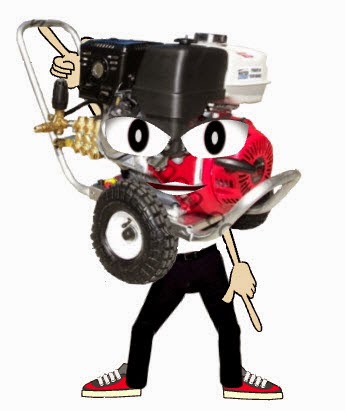Water Cannon has repair parts and kits to fix
your pump. In so many cases we find or should I say cannot find the label
that has the model number on the pump as shown in this picture. Of course
this is critical to ensure we send you the correct parts to fix your pump problem. A Picture like this is worth a thousand words.
Sometimes we can identify the pump even without the head or manifold
removed as shown. This can be a little like the crime dramas you see on
TV. I call it: PSI. Pump Scene Investigation. I can
tell by the picture that is a belt drive. I can see by the crankcase
of the pump and shape of the manifold that this is a General Brand Pump.
To identify the pumps actual model number, with the manifold already removed,
you can measure the outside diameter of the white ceramic Plunger or
piston in millimeters. That will give us the bore of the pump piston.
To measure the stroke or how far back and forth that same piston travels, hold
a ruler next to the piston as you turn the crankshaft of the pump and
then see how many millimeters in one direction the piston travels.
If the label is missing from your pump, all of this information combined will
ensure the correct pump identification. Call Water Cannon to
order the correct parts to get you back up and running, right the first
time.
In looking at the pump that we just talked about above, your
eagle eye may have picked up the crack running down the length of the piston.
This crack is caused most often by what is known as “Thermal Shock”.
Thermal Shock is what happens to a piston or plunger when it sees a drastic
temperature change usually from hot to cold. The most common
example is when a pressure washer is started before the water is turned
on. The friction from the dry plunger against the seals can heat up
in seconds. It may be too late before the operator realizes that there is
no water to the pump. By the time the user gets the water
turned on, the plungers are hot. When the cold water is
introduced, this shocks the ceramic and a crack is formed. This
will cause the seals to fail and leak water back into the
crankcase. If left undetected, catastrophic damage can occur such as thrown
connecting rods due to poor lubrication. The moral of the
story: Always have water flowing through the pump before start up.
Written by Jim Grode

.gif)











.gif)



.gif)






